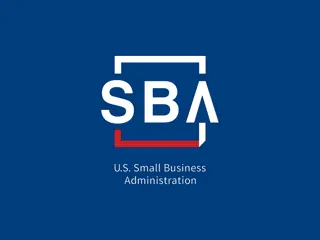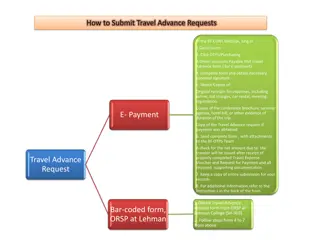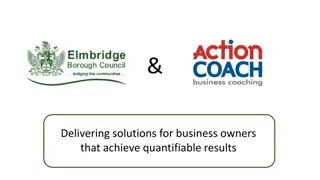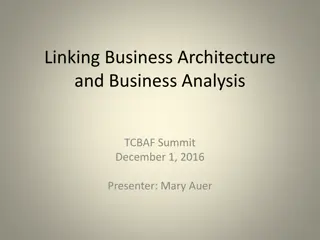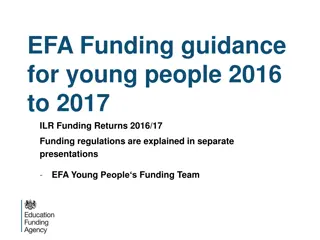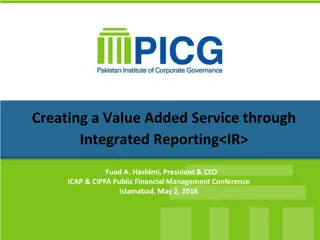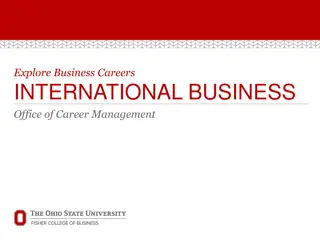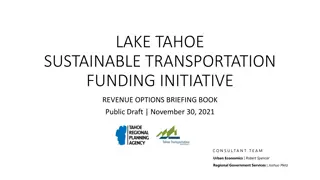Obtain Business Funding: Funding Options and Strategies for Success
Funding options, understand debt vs. equity, and learn to approach lenders effectively to secure capital for your business growth. Gain insights into strategic financing decisions to maximize rewards and minimize risks. Align yourself with the right investors for guidance beyond just monetary support.
Download Presentation

Please find below an Image/Link to download the presentation.
The content on the website is provided AS IS for your information and personal use only. It may not be sold, licensed, or shared on other websites without obtaining consent from the author.If you encounter any issues during the download, it is possible that the publisher has removed the file from their server.
You are allowed to download the files provided on this website for personal or commercial use, subject to the condition that they are used lawfully. All files are the property of their respective owners.
The content on the website is provided AS IS for your information and personal use only. It may not be sold, licensed, or shared on other websites without obtaining consent from the author.
E N D
Presentation Transcript
Obtain Financing For Your Business FUNDING OPTIONS TO START AND GROW YOUR BUSINESS M. HOWARD GOBER JR. ( HOWIE ) www.score.org
Homework Assignment You have probably completed it Even though you didn t know it was due What if I asked you to pause this presentation just for the next 30 minutes? Use the time to go raise capital for your business and report back to me Where would you search? What is the first idea that popped into your head? www.score.org
Homework Assignment Part 2 In 30 minutes time: Would you know what to ask for? Would you be able to describe where your business is right now? Can you define Capital ? Understanding where to find funding and what type is the first step www.score.org
Fast Forward to the End Your goal(s) as the business owner to obtain funding: Know whether you need DEBT vs EQUITY Demonstrate how you/your business can limit/understand the risks and maximize reward Deliver a roadmap to lender/investor showing competency, positive results and being prepared to turn money into profit The more you understand about your business stage in its life cycle and the financial statements behind it the greater your success. Try to align yourself with a lender/investor that can also offer experience or advice . This can provide more than just funding and a cost to the money www.score.org
Debt vs Equity Understand the difference This can cut funding search time in half depending on your need Debt (loans): Involves interest expense, doesn t give up ownership, usually less expensive But also comes with payment schedules! Equity: Gives up ownership, more expensive, higher risk tolerances May not have set payment schedules, more event dependent for payback www.score.org
Your first 30 minutes Do you assume that bank financing, venture capital or alternative loan applications may be daunting, overwhelming or approach impossibility? At the beginning of a lending relationship, lenders also have no idea how you think It is your job to figure out where you are www.score.org
The Credit Industry (How Lenders Think) You have a risk profile (more on this later) and so do lenders Your business has something to sell (goods or services) Lending is the only industry where what it sells, it wants to get back with a return just like you. Risks Incurred vs. Reward Earned Yield on spread vs risk Every business has some form of this! Different lenders are compensated for the risk (Debt vs Equity slide) Lenders always think about: What is the primary source of a borrower s repayment and/or collateral? www.score.org
How Does Your Business Think? It has many more needs than just financing! When you get to the financing component, you have recognized a need Why does your business need funding? Think about what stage or life cycle your business currently resides: Start-up, Revenue, No Revenue, 2 years old, or older and seasoned and where it lies with regards to financing needs What are the risks a potential lender/investor would need to know? www.score.org
Business Financing: As you consider funding from a lender think carefully about: Are you asking for too little Are you asking for too much What payback schedules you can afford Do you have a business plan Some lenders with a high risk appetite still need to see your idea on paper What are you willing to concede? What do you expect if your business fails or succeeds! Go back to Debt vs Equity consideration after thinking through this www.score.org
Business Financing Matching of Borrowing Needs When asking Why do I need the loan? : Is it for Working Capital (day-to-day bills as you wait for invoice payments) Is it for Equipment Is it for Inventory Is it for Real Estate (Do I want to own something or lease it?) No 20-year car loans!! Don t buy a building with Working Capital www.score.org
Business Financing One more Consideration: Financing Types: Proactive vs. Defensive Financing I just landed the Home Depot account! I can t pay payroll next week. Things are going well, let s put a reserve in place. The timing of my invoice receipts is abysmal. These examples all tie into timing/risk/sources/uses and cost you might pay for funding www.score.org
What Should My Business Think About? What is YOUR Risk profile? You need to line up your risk profile with your lender This is very important. It can set the standard for what both sides expect now and in the future. It will also determine where to look for a lender I want to borrow money to invest in commodities because it sounds neat. I ve been to 6 lenders and none of them are buying into my idea. You want to eliminate this Relationships help www.score.org
What Should My Business Think About? How risky is my business? How risky would it be viewed by others? What stage is my business Do I need short term or long term money? Do you know and understand your opportunity cost Alternative cost of capital Example: Stock portfolio vs your own business www.score.org
What Should My Business Think About? What is my liquidity premium? This is a great discussion point with a lender Is cash king? Absolutely! No way. Why would I have idle cash just laying around? Many customers view this in entirely different ways www.score.org
When You Approach a Lender for Financing: Consider these 4 Propositions: Here is what I want Here is what I will do with it Here is how it gets paid back Here is what happens if it fails (The lender wants you to succeed.) www.score.org
When You Approach a Lender for Financing Know what your financial statements mean The big three: Income Statement Balance Sheet Cash Flow Statement (And how all of these tie together) The other one: Projections (Are they realistic?) www.score.org
When You Approach a Lender for Financing Consider your resources, your capabilities and where to start first Understand the Lender or Financial Hierarchy for credit sources: Defined as: a form of capital structure determining the order importance of certain financial resources. smallbusiness.com At certain levels and structure, money is not equal relative to its cost The further you go down in the hierarchy, the greater the cost, risk, rules or structure Try to avoid: I have no idea It may sound silly, but it happens www.score.org
Hierarchy Example A starting list: Yourself/The Business Owners/Retained Earnings Friends/Family/Fools The Three F s Credit Cards (this may fit in more than one spot on the Hierarchy) SBA lending Banks (Large and Small each play different roles) Internet Resources (ie CrowdFunding) Angel Investors Venture Capital (lots of rules but also lots of resources) Issue Stock Both public and private offerings www.score.org
Yourself and the 3 Fs No one knows you best If you are pursuing funding you probably understand the risk/reward of these options already www.score.org
Credit Cards May be quick and easy if personal or business credit is good Rate advantaged for the Short Term but gets expensive later May not provide enough capital May be more expensive down the road and more costly beyond actual money www.score.org
SBA Lending Good attributes Bad attributes Wide range of businesses Down payment Varying loan amounts Potential Collateral requirement Capped and variable interest rates Personal liability if business fails Could qualify even if denied traditional loans Delayed approval process Bank Guarantee helps with approval Poor credit may not get approved www.score.org
Bank Financing Risk adverse by nature Lower risk profiles Make collateral based credit decisions and/or steady cash flow Have favorable terms Won t have to give away ownership (unless you default!) www.score.org
Internet Resources Have become more widely used Have quick ability to connect need/idea with capital Start engine www.score.org
Venture Capital vs Seed Capital Seed Capital might get you going Venture Capital likes to see a company with proven product, growing revenue and several years operating history Have ability to invest several times/rounds Invest in industry specific transactions (companies/industries they understand) VC invests in companies past the seed stage Investors in this area are confident and more comfortable taking on greater amount of risk but will also ask for more of the reward www.score.org
Stock Issuance Private Placements (no secondary market) Public offering (Raises initial capital then trades in secondary market) You are giving company ownership to others with who have an expected rate of return www.score.org
When You Approach a Lender for Financing Understand the timing and need of your request Each lender will have different needs, documents and time considerations Other sources and considerations: Factoring (Account Receivable Selling) Finance Companies Specific Equipment Lenders Leasing Companies www.score.org
Bonus Points Understanding: Cost of Equity The rate of return an investor requires from an equity investment for it to be considered worth the risk. Investopedia Inversely: the return that a company must realize in exchange for a given investment of project. - Investopedia Capital Structure The particular combination of debt and equity used by a company to finance its overall operations and growth. Investopedia Cost of Capital total cost of raising capital both equity and debt.-Investopedia A company needs to use its overall lowest cost of capital option as it pursues funding www.score.org
The Big Picture All of your business financing works together in a partnership no matter what life cycle the business resides. Capital/Equity Long-Term/Short-Term Debt SBA loans Many Others Remember: No risk, no reward Find where your business fits in the Hierarchy, target it and pursue financing at that level. www.score.org
Go back to the homework assignment at the beginning. How would you spend the 30 minutes to pursue funding now? The same way? Would you change your approach? www.score.org







